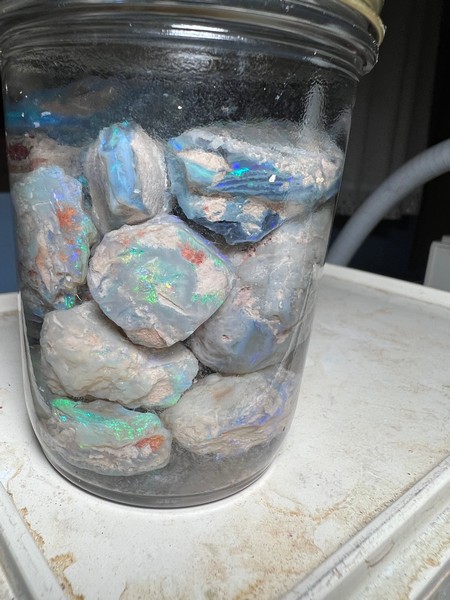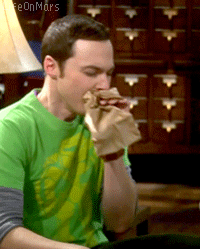|
|
Post by hummingbirdstones on Jun 24, 2024 21:59:00 GMT -5
Just for fun, here's some pics of a jar of Coocoran nobbies I've had for probably 20+ years.   |
|
|
|
Post by jasoninsd on Jun 24, 2024 23:08:25 GMT -5
Just for fun, here's some pics of a jar of Coocoran nobbies I've had for probably 20+ years.    |
|
|
|
Post by opalpyrexia on Jun 25, 2024 11:27:51 GMT -5
The real question here is (for the experienced cutters) did I do good? I’m planning on buying some even more expensive opal. I’m talking $1000+ knobbys of black opal. Getting my skills down on the coober cutting them straight out of the rough. Yes, you did good, very good. Earlier you had said, "Then came in from the back to start anticipating girdle thickness." That's an interesting question with regard to opal. Opal is a precious gemstone of potentially considerable value, even rivaling diamonds, rubies and other gems. That's why opals are measured in carats rather than grams or some other unit. Every carat counts... The style of cutting will affect its value. Here's three ways to cut this rough opal. Profile A shows the opal being given a girdle, cutting that will reduce the opal's potential value. Profile B is a traditional opal cabochon shape that is very typical for opal, and being heavier than A would be more valuable. Profile C is how opals are cut for the Australian market: they have a belly that can add considerable weight. I have read that most (nearly all?) opals in Australia that are in jewelry are preferred prong-set, and that the belly is analogous to a faceted gem's pavilion and therefore acceptable. It' does nothing for the fire, it's just added baggage that boosts the price.
|
|
|
|
Post by Rockoonz on Jun 25, 2024 11:29:34 GMT -5
My opal experience is limited to cutting a little boulder, a little colorful potch, and a handful of spencer triplets. I think the triplets are a great form of practice on finding that band of flash and exposing it, since the bands can often be quite thin and if (when) I ruin one, the financial loss is pretty minimal.
I still have a supply of backed spencers somewhere, ready for caps, but kinda lost interest in all but the fairly rare pinfire examples, the ones I call sheet fire are really pretty unremarkable to me, but the pinfire shows well under the quartz cap that acts as a magnifying glass of sorts. Either way, the value of a doublet or triplet, and the extra labor to make one, really make them hardly worth cutting if you do it for money.
|
|
|
|
Post by Rockoonz on Jun 25, 2024 11:55:00 GMT -5
opalpyrexia never thought of the weight angle, but being that they are a precious gemstone like a faceted stone makes sense. With something thicker like a nobbie, I wonder if it makes sense to start by doing a little rough shaping into something kinda spherical to window them and find the best angle to cut, then split at that angle like a star garnet for 2 finished stones? I have split Spencer before when it had more than one band on a promising piece, just sandwiched it between a couple basinite backers then split down the middle. I understand the economic logic of the Aussies making more for their labor by only cutting one cab, then selling by weight, but isn't a thinner less lumpy opal much more attractive when set as a ring, pendant or earrings especially?
|
|
realrockhound
Cave Dweller  Chucking leaverite at tweekers
Chucking leaverite at tweekers
Member since June 2020
Posts: 4,488
|
Post by realrockhound on Jun 25, 2024 11:55:23 GMT -5
The real question here is (for the experienced cutters) did I do good? I’m planning on buying some even more expensive opal. I’m talking $1000+ knobbys of black opal. Getting my skills down on the coober cutting them straight out of the rough. Yes, you did good, very good. Earlier you had said, "Then came in from the back to start anticipating girdle thickness." That's an interesting question with regard to opal. Opal is a precious gemstone of potentially considerable value, even rivaling diamonds, rubies and other gems. That's why opals are measured in carats rather than grams or some other unit. Every carat counts... The style of cutting will affect its value. Here's three ways to cut this rough opal. Profile A shows the opal being given a girdle, cutting that will reduce the opal's potential value. Profile B is a traditional opal cabochon shape that is very typical for opal, and being heavier than A would be more valuable. Profile C is how opals are cut for the Australian market: they have a belly that can add considerable weight. I have read that most (nearly all?) opals in Australia that are in jewelry are preferred prong-set, and that the belly is analogous to a faceted gem's pavilion and therefore acceptable. It' does nothing for the fire, it's just added baggage that boosts the price.
when o say come in from the back, I’m referring to the amount of host/potch that was below the fire bar. Material that shows no sign of color. Just rough potch that needed to be cleaned up. The fire bar was fairly thin all things considered, so I left as much of that as I could. Then cleaned up the rest to a relative thickness so it could be set in a bezel. I have been watch a bunch of black opal direct, and using some of that guy’s techniques when cutting |
|
|
|
Post by opalpyrexia on Jun 25, 2024 13:25:04 GMT -5
opalpyrexia never thought of the weight angle, but being that they are a precious gemstone like a faceted stone makes sense. With something thicker like a nobbie, I wonder if it makes sense to start by doing a little rough shaping into something kinda spherical to window them and find the best angle to cut, then split at that angle like a star garnet for 2 finished stones? I have split Spencer before when it had more than one band on a promising piece, just sandwiched it between a couple basinite backers then split down the middle. I understand the economic logic of the Aussies making more for their labor by only cutting one cab, then selling by weight, but isn't a thinner less lumpy opal much more attractive when set as a ring, pendant or earrings especially?
I would agree generally that being able to get two good cabs from a piece of rough is better than just one good cab. You created two cabs from the Spencer, both doublets. All factors equal, "a doublet is worth one-tenth to one-twentieth the value of an equivalent solid opal". That's a quote from "Opal Identification & Value" by Paul Downing. He also points out that backing opal with a black substrate can make a doublet face up like a black opal, which is one reason for the reduced value being so great.
And I do agree with your last point. If I can make a hot doublet or two, especially when the fire is greatly improved, I generally sometimes do so.
|
|
jasonm210
off to a rocking start

Member since June 2024
Posts: 2
|
Post by jasonm210 on Jun 25, 2024 18:54:56 GMT -5
Just for fun, here's some pics of a jar of Coocoran nobbies I've had for probably 20+ years.    |
|
|
|
Post by Rockoonz on Jun 26, 2024 13:25:16 GMT -5
opalpyrexia never thought of the weight angle, but being that they are a precious gemstone like a faceted stone makes sense. With something thicker like a nobbie, I wonder if it makes sense to start by doing a little rough shaping into something kinda spherical to window them and find the best angle to cut, then split at that angle like a star garnet for 2 finished stones? I have split Spencer before when it had more than one band on a promising piece, just sandwiched it between a couple basinite backers then split down the middle. I understand the economic logic of the Aussies making more for their labor by only cutting one cab, then selling by weight, but isn't a thinner less lumpy opal much more attractive when set as a ring, pendant or earrings especially? I would agree generally that being able to get two good cabs from a piece of rough is better than just one good cab. You created two cabs from the Spencer, both doublets. All factors equal, "a doublet is worth one-tenth to one-twentieth the value of an equivalent solid opal". That's a quote from "Opal Identification & Value" by Paul Downing. He also points out that backing opal with a black substrate can make a doublet face up like a black opal, which is one reason for the reduced value being so great. And I do agree with your last point. If I can make a hot doublet or two, especially when the fire is greatly improved, I generally sometimes do so.
Yep, doublets and triplets are not a good way to bring in any meaningful income from your work, but they do create a durable, stable cab that can become part of everyday wear jewelry. Good opals tend to be locked away in the dark and seldom worn for fear of them drying out and becoming worthless from too much time in the daylight, just like some other colored gemstones that don't do sunlight well. |
|